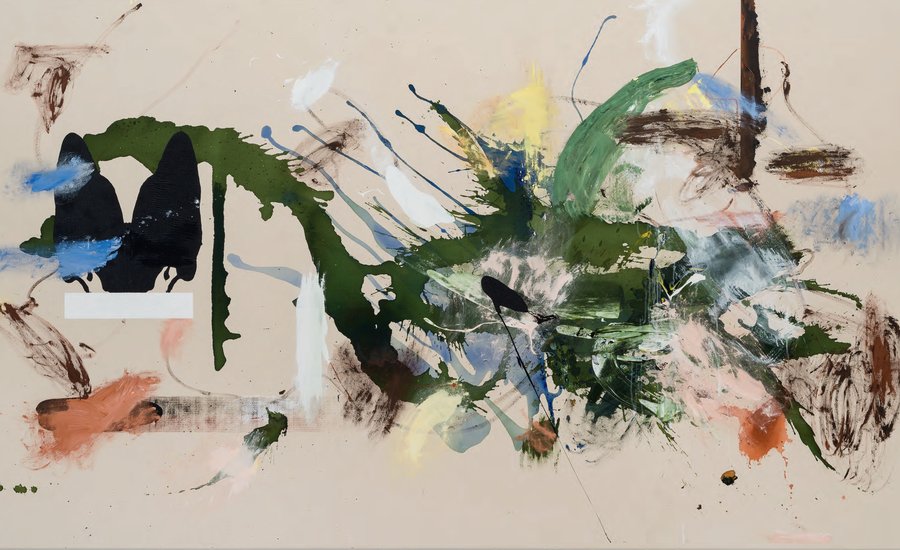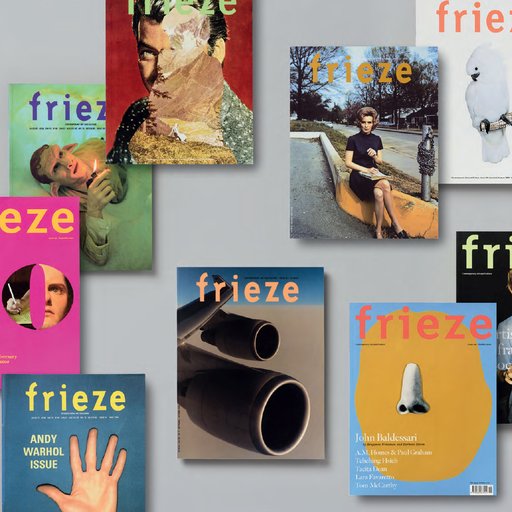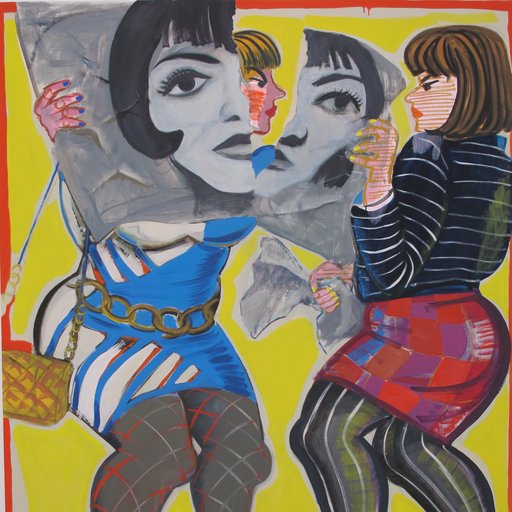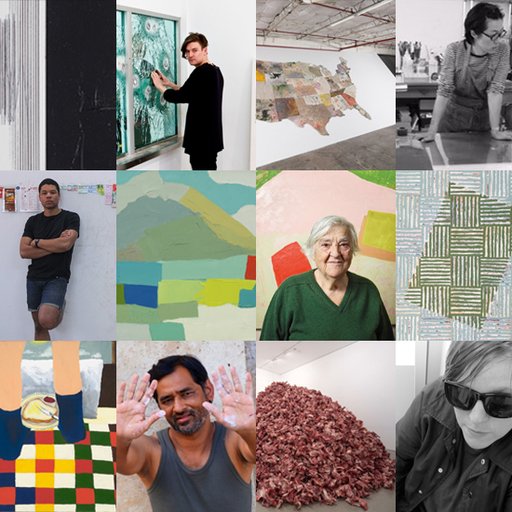Abstract art may have shocked the world when it appeared in the wake of Modernism, but its widespread acceptance over the intervening century means that non-figurative works are now at the center of contemporary painting. (Sometimes to a fault—see the “crapstraction” craze of the early 2010s.) This doesn’t mean that there have been no new developments, of course—as this excerpt from Phaidon’s new Vitamin P3shows, some painters are constantly experimenting to find novel new tools with which to expand the purview of the medium.
CHRIS MARTIN
Born 1954, Washington, D.C. Lives and works in Brooklyn, New York.
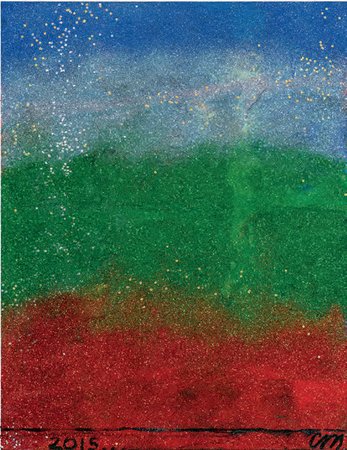
Chris Martin believes in painting. His most recent canvases, with their glitter and high-octane colors, are clearly an assault on the eye, but more importantly they are an assault on anyone who believes that painting has lost its vitality. If they are confrontational it is because they brim with passion—a passion for the materiality of painting certainly, but also a passion for painting as a transcendental act. His work seems to look back to the Romantic tradition as much as to modernism, to literary figures as disparate as Rainer Maria Rilke, Walt Whitman, Edgar Allen Poe, and Samuel Beckett.
Martin is very much an American painter and works between studios in Brooklyn and upstate New York. Works such as Red, Green, Blue, Glitter Landscape (2015) seem to wear the legacies of the New York School of the 1950s and 1960s lightly, as though the color field had been taken on a mystic detour into the cosmic. His paintings absorb a plethora of conflicting and congruent influences, which seem to play off and against each other. Throughout his canvases there are references to both his deep love of the bucolic and rural, and to the urban at its most “street.” He has been known to work outside and even to let the weather roughen the surface of a painting; his paintings have been photographed in streets, on the Brooklyn waterfront, and hung on the exterior fascia of galleries.

Martin has cited his experience as an art therapist in the 1990s, when he worked with drug and HIV-positive patients, as a catalyst to be braver and more daring as a painter. It is a bravery that echoes the stance of many of the painters that he admires, be it the visionary and more marginal figures like Forrest Bess (1911–77), Alfred Jensen (1903–81) or Paul Feeley (1910–66), or the energetic re-invention found in the work of Picasso (1888–1973) or even Sigmar Polke (1941–2010). Martin’s provocations can be seen in the way he uses and confuses materials and subjects, for example when he marries the spectacle of glitter with gestural and trippy representations of plant and fungi forms, such as in Untitled (2014). Other paintings may pay homage to his musical heroes, like The Beatles, Amy Winehouse or James Brown, through jamming together formalism, collage and text.
Since the mid-1990s Martin has also painted monumental yet subtly fragile paintings, made on thin canvas, initially with simple matte-black house paint and frail white drawn lines, but more recently exploring bolder colors. These canvases are normally ten or twelve feet high, some much bigger, perhaps recalling painted stage scenery (which is traditionally at odds with supposedly high-brow painting). In an early catalogue essay, the artist Peter Halley (b.1953), whom Martin met when they were both students at Yale University, described these works as transgressive, due to their unswerving use of scale, materials and dark Romantic subtext. By these means they directly emphasize ideas that are mainstays in all Martin’s work: belief, spirit, and affect.
— Daniel Sturgis
MARY WEATHERFORD
Born 1963, Ojai, California. Lives and works in Los Angeles.

California native Mary Weatherford has been called a landscape painter, but she is emphatic that she does not work in this tradition. Because many of her paintings are titled after places—including Los Angeles, Bakersfield, Manhattan, and Coney Island—they have been interpreted as visual depictions of those sites, albeit in abstract forms. Weatherford characterizes her art as situational and experiential, based on her interest in capturing the sublime aspects within everyday moments and events that she finds rooted in urban encounters. Her imagery is not grounded in representation or memory as much as in what she calls a complex imaginary experience of a situation—a fantasy or reimagining of a moment in time and space.
Weatherford sees her work as being about her experiences—the situations and people she encounters—on the street, at the beach, and as part of her daily comings and goings. Double Wave at Windansea (2015) for example, was inspired by an event in San Diego, during a high tide swell, when the ocean was full of body surfers and boogie boarders. She recounts how she went, saw, experienced the episode, came home, and made the painting. As such, she considers this work to be about that particular moment in time, rather than about the landscape or that genre of painting. Likewise, The River (2015) conveys her experience one day at the Los Angeles River, where she witnessed a man undress, neatly fold up his clothes, go into the water, bathe, get out, and re-dress—a situation she has reimagined as a local version of bathing in the Ganges, about which she has remarked, “You never know who the Buddha is.”

Weatherford lived on the east coast of America for twenty years, and her early work was influenced by her time spent in Manhattan in the 1980s—where she had a studio in the East Village—trips to Coney Island, wanderings through Chinatown, and evening views of the illuminated Empire State Building. Because her work is often about certain moments in the day, featuring summer skies and urban lights, the paintings seem embedded with references to weather as a marker of the conditions of a place or situation. These encounters are offered to others through her paintings as universal conditions or concerns.
In 2012 Weatherford began incorporating neon into her paintings, a material that embodies her experience of and ideas about the lights and movement within cities. The first group of paintings to include neon was inspired by driving through the small city of Bakersfield, California at night, past an array of illuminated signs on shops, bars, pharmacies and other city sites. For all its ubiquity, neon remains a handmade product, fabricated uniquely by craftspeople. Taking its place on her canvases, the neon tubes function as three-dimensional lines of light that are always slightly crooked and imperfect, creating neither legible shapes, letters, or words. By pointing to the external world, the neon takes these works beyond the interiority of abstract painting, without ultimately being a representation of anything other than itself—an addition of color and light to the canvas.
—Rochelle Steiner
ELIZABETH NEEL
Born 1975, Stowe, Vermont. Lives and works in New York.

In the work of Elizabeth Neel there is a tension between figuration and abstraction. Her paintings are acts of accumulating fluid, immediate gestures within a narrative trajectory. She believes in action and response. Gestural marks are historically associated with emotions; but for Neel, there is no problem in the historical coding of emotion, she cites and works with this information, using emotion as a narrative strategy and tracking the historical progress of painting. As the granddaughter of the indomitable portrait painter Alice Neel (1900–84), the younger Neel is aware of the past but is emphatically of this moment. Her paintings could only emerge now, in a digital age, when the past is seemingly accessible in endless variations online. While her paintings are not digital or high tech, their context and intellectual rigor are reflective of our high tech moment.
Neel takes risks—shifting from oil to acrylic paint and constructing sculptural works as extensions of the spatial dynamics of her paintings. Unlike digital processes, Neel can’t revert to an earlier version—she has to proceed without erasing. The performative aspect of her marks recall painters such as Jackson Pollock (1912–56) but also, in less obvious ways, performance artists such as Gilbert & George (b.1943, b.1942). Sometimes Neel folds a wet canvas to create images that resemble those found in Rorschach tests (whereby a patient of psychoanalysis is shown abstract patterns and asked to identify what he or she can see). In The Builder (2015) the symmetrical result from such a fold-over creates what could be interpreted as a body viewed from above, or, alternatively, a strange animal face or totem. Building, as with painting, is an optimistic act that is also destructive. While Neel’s titles can be difficult to explain, The Builder reveals how Neel constructs potential meaning that remains unresolved.

Because the paintings are abstract but reference figuration, Neel’s use of language is both specific yet poetic. Her titles are vital components, expanding on narrative suggestions made within the paintings. ADBC (2015) references the alphabet, but is disordered. This is how history is formed; it is not ordered systematically as it occurs. Sometimes we have to recuperate a perspective, or reflect on the bias of another to realize what has been omitted. With the intensity of applied paint in thick strands of splashed-on blues that veer toward black at the centre and swathes of raw canvas on the edges, ADBC is like the visualization of the big bang—history swirls out as it is being formed. If it can be said that all history is patched together, Neel’s practice displays the same progressive and regressive tendencies. The artist doesn’t believe in “newness” as a stipulation for what artists do. One can use history and productively repeat aspects of what one’s predecessors have made, but the very act of choosing it makes it relevant now.
—Kathleen Madden
[related-works-module]











